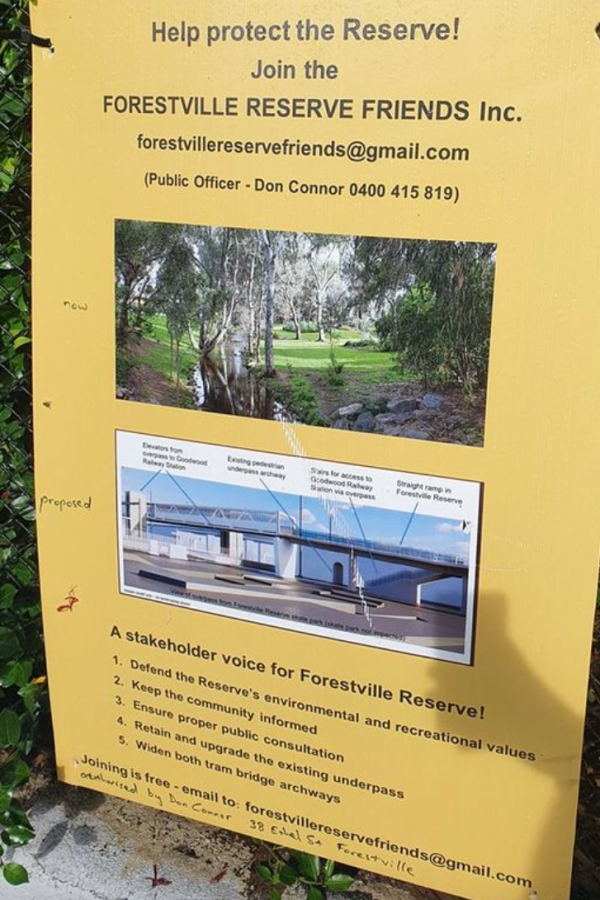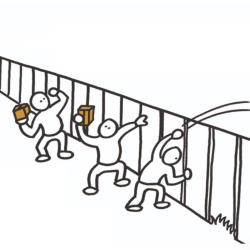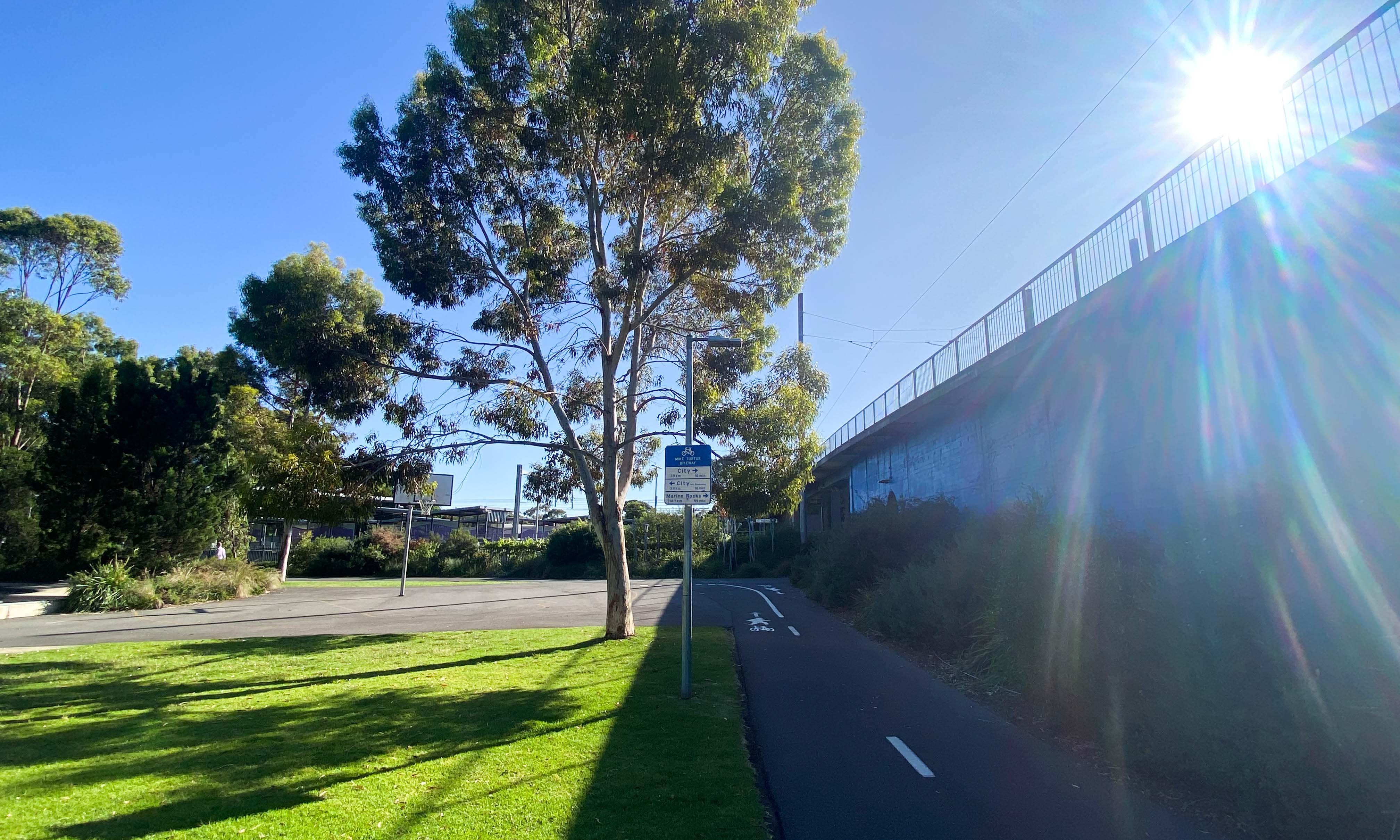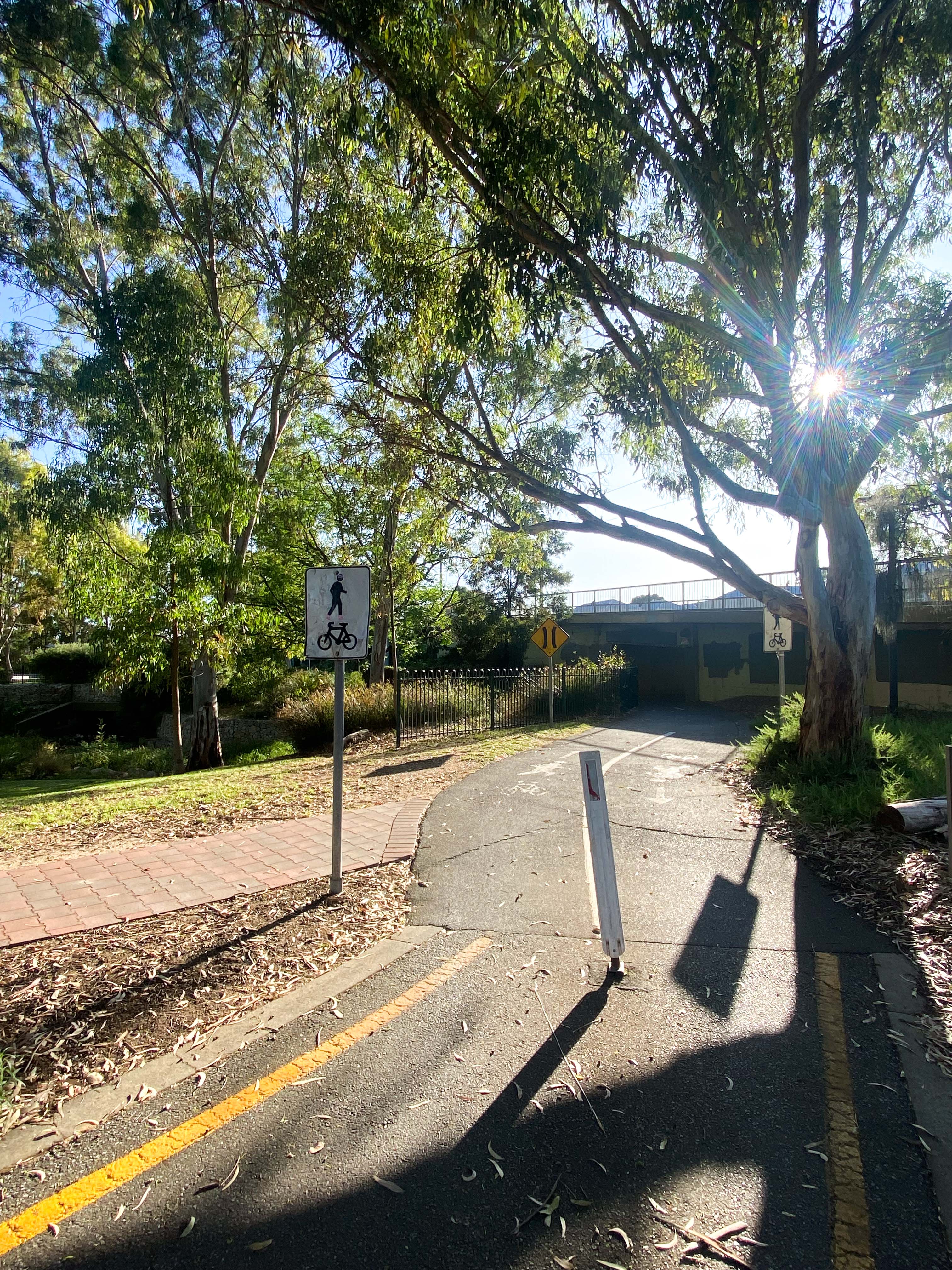Conservationists and cyclists would seem like good bedfellows, but a proposed bicycle overpass which will encroach upon a Forestville reserve pitted the two against each other in a clash of corflutes and Facebook posts.
How a proposed cycling overpass exposed a thorny green divide
There was a logical solution to what seemed at first like a Southern Suburbs Noir: who stole the Forestville Reserve Friends anti-Mike Turtur Bikeway Overpass posters?
It was a mystery that briefly troubled Don Conner, a member of the Friends, who told CityMag he wanted whoever stole the posters to reimburse the group for the cost of printing them.
As it turns out, it was the Unley City Council who took them down. They’d received complaints about the validity of the information on the posters, and their effect on the visual amenity of the Forestville Reserve. Simple enough.
But the posters’ disappearance revealed a more curious rift in the community, between two seemingly aligned groups: the Forestville Reserve Friends, an environmental conservation group, and Unley Bicycle Users, an active transport Facebook community.

One of the missing posters, pre-theft
Don Conner, a resident of the Unley council area since 1976, was the man responsible for producing the disappeared corflutes and has been advocating for the reserve, which abuts the Goodwood Railway Station, since it was established in the ‘80s and ‘90s. Prior to the Forestville Reserve Friends’ intervention, the plot of land was fenced off and used as a car park.
“Over the years, we’ve managed to get the reserve to what it is today,” Don says, referencing its willowy trees, carpet of grass and trickling creek.
However, the group holds new concerns for the place. They’re worried the planned Goodwood Railway Station tram overpass upgrade, which includes a cycling path, could lead to the loss of trees and green space, with car parks making a return.
The project was first spruiked by the 2016 Weatherill Government at a cost of $10 million, a figure which has increased dramatically since. InDaily reported in February this year it would cost $25 million, with construction expected to be completed by mid-2023.
A Department for Infrastructure and Transport spokesperson tells CityMag the project, which aims to be the final piece of the Mike Turtur Bikeway puzzle, will now cost $35 million. The government will also consider the outcomes of community engagement and overall “budget” before making a decision on the next stage.
In addition to his role with the Friends, Don is one of 12 members sitting on the Public Transport Projects Alliance Community Reference Group. This is a collection of locals and cyclists who meet regularly and give their feedback to the lead contractor, PTP Alliance.
The Forestville Reserve Friends have long been wary of the Mike Turtur Bikeway Overpass. Don says the project will have a massive impact on the area, which he says includes the felling of roughly 50 trees. They’re also concerned about the potential for graffiti.

A website run by another group, not the Forestville Reserve Friends, also claims the infrastructure will include “more places to hide”, which it suggests is a safety concern for women, and posits a theory, through text and illustration (see right), that “people/vandals will have fun throwing things off the overpass”.
The Friends printed and hung up the posters in the area. Headlined “Help protect the Reserve!”, the posters had two images: a photograph labelled ‘now’ and a render of the impending overpass labelled ‘proposed’.
Before Unley Council removed the posters, they caught the ire of Patrick Swanson, a local cyclist, who took to the Unley Bicycle Users Facebook group to post about what he describes as the “incredibly misleading… misinformation” on the posters.
“Using a photo of Brownhill Creek labelled ‘now’ vs an undetailed mockup of the overpass is incredibly misleading. On viewing this sign it is easy for people to think that the proposal is to concrete the entire reserve, including the creek,” he said in the post.
“The substantial amount of misinformation from the anti-overpass campaigners has been incredibly frustrating through this entire process.”
Patrick also previously communicated his displeasure directly to the Friends, in an email addressed to Don, whose name and contact details were listed on the poster, asking why the group had chosen to use “misleading” images on the posters.
Don’s partner, Eileen Connor, responded to Patrick’s emails (she signed off with her name), saying the first photograph was taken from the small bridge overlooking the creek, and aimed to capture the same viewpoint as the second rendered image.
—Eileen Connor
“I think what the two pictures are saying is that looking towards the tram overpass from the small bridge [and] all the trees in the background will be removed to make way for a 35,000,000 dollar overpass,” Eileen says via email.
Don echoes this message to CityMag when we speak.
“There were two photos on the posters. One photo was taken from the little footbridge, near the pool, looking towards the underpass, and the other one was a mock-up, which was supplied by the contract as PTP (Alliance) of what was proposed from the same angle,” he says.
“I don’t think the posters were misleading. I think they were okay. That’s the best we could do and that’s what we tried to do.”
New here? Sign up to receive the latest happenings from around our city, sent every Thursday morning.

Goodwood Train Station, which is parallel to a basketball court and skatepark
Another element of Eileen’s email antagonised Patrick, though. She closed off the message by suggesting dedicated cycling infrastructure, such as the overpass, was not needed. “We already have bike infrastructure, roads,” she wrote.
This refrain is familiar to Patrick. He says it’s indicative of the “anti-bike-lane, anti-bike-infrastructure arguments” often bandied around during bicycle infrastructure debates. This rhetoric is usually followed by the suggestion that cycleways are a waste of time and money and no one will use them, he says.
“But the City of Unley, and in particular Goodwood, Forestville, Black Forest area, actually has some of the highest rates of bike commuting in all of South Australia,” Patrick says.
“That’s because we have good infrastructure, but we still have these gaps in our infrastructure that we still need to fix.”
According to the City of Unley’s Walking and Cycling Plan 2022—2027, 4.5 per cent of its residents cycle to work. This is the largest amount of bicycle commuters in all metropolitan councils, the document states.

The reserve
Despite the feud between the two community groups, Don, who is one of Unley’s many cyclists, is not against the concept of cycling infrastructure – he even tells CityMag he has concerns regarding other roads in the area. It’s the design of the overpass where his problem lies. Don wants to see other less impactful options.
For Patrick, the issue is in what he describes as Australians’ small-scale, localised view of environmentalism.
—Patrick Swanson
“One of our major issues with the environment in Australia is land use and transportation,” he says.
“If all we build is car-based infrastructure, and all we do is encourage people that drive cars everywhere, then that leads to a significant, and has led to a significant amount of green space loss.”
While there seems to be plenty of space for Patrick and Don to find common ground, the ideological gap, though seemingly slight, seems insurmountable.
How a proposed piece of cycling infrastructure could drive such a thick wedge between otherwise aligned individuals is a small mystery, but an important one to consider as governments of all levels work to provide their constituents with more green space and less carbon-intensive transport options.




